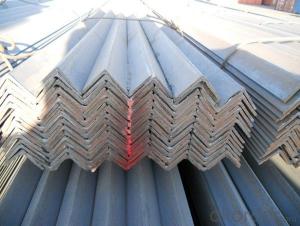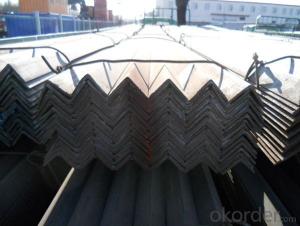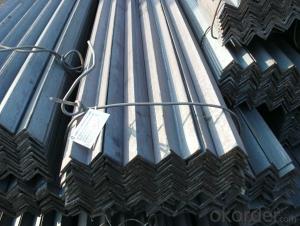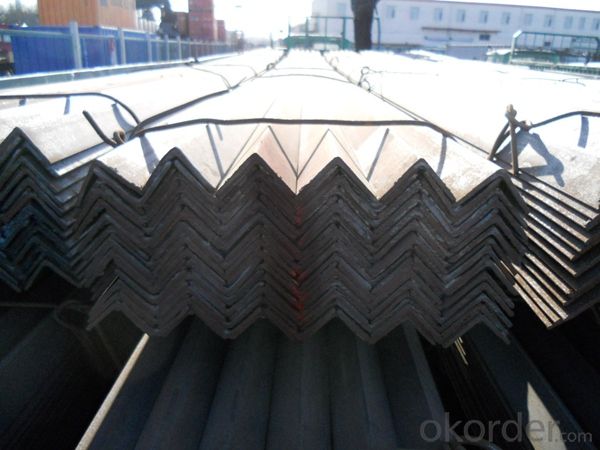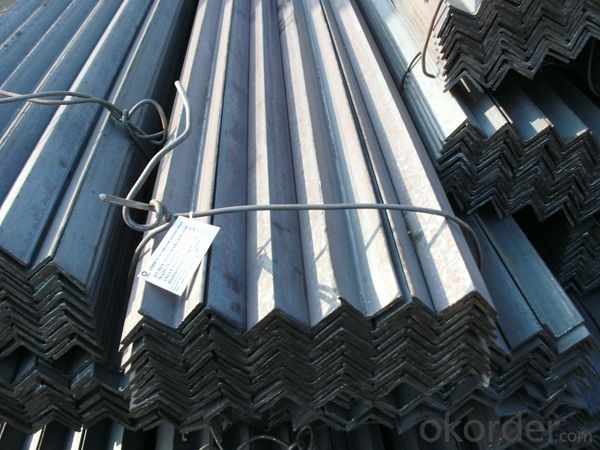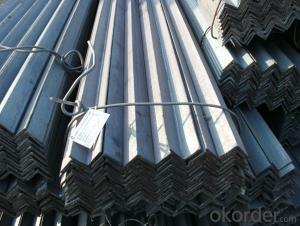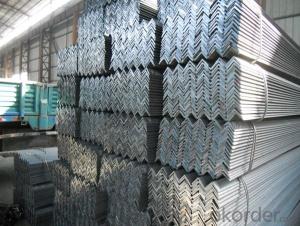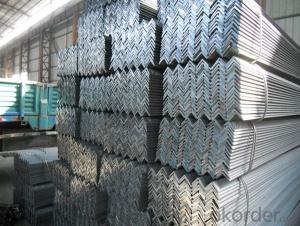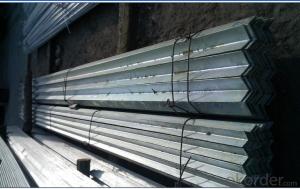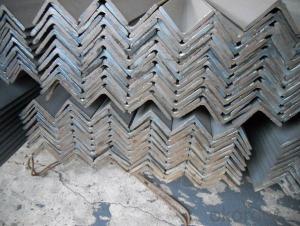High Quality Steel Angle Beams for Structure and Construction
- Loading Port:
- Tianjin
- Payment Terms:
- TT or LC
- Min Order Qty:
- 25 m.t.
- Supply Capability:
- 200000 m.t./month
OKorder Service Pledge
OKorder Financial Service
You Might Also Like
Product Description:
OKorder is offering High Quality Steel Angle Beams for Structure and Construction at great prices with worldwide shipping. Our supplier is a world-class manufacturer of steel, with our products utilized the world over. OKorder annually supplies products to African, South American and Asian markets. We provide quotations within 24 hours of receiving an inquiry and guarantee competitive prices.
Product Applications:
High Quality Steel Angle Beams for Structure and Construction are ideal for structural applications and are widely used in the construction of buildings and bridges, and the manufacturing, petrochemical, and transportation industries.
Product Advantages:
OKorder's High Quality Steel Angle Beams for Structure and Construction are durable, strong, and wide variety of sizes.
Main Product Features:
· Premium quality
· Prompt delivery & seaworthy packing (30 days after receiving deposit)
· Can be recycled and reused
· Mill test certification
· Professional Service
· Competitive pricing
Product Specifications:
Manufacture: Hot rolled
Grade: Q195 – 235
Certificates: ISO, SGS, BV, CIQ
Length: 6m – 12m, as per customer request
Packaging: Export packing, nude packing, bundled
| EQUAL ANGLE STEEL | |||||
| size(mm) | a(mm) | a1(mm) | thickness(mm) | kg/m | length |
| 50*50*4 | 50 | 50 | 4 | 3.059 | 6m,9m,12m |
| 50*50*5 | 50 | 50 | 5 | 3.77 | 6m,9m,12m |
| 50*50*6 | 50 | 50 | 6 | 4.465 | 6m,9m,12m |
| 63*63*5 | 63 | 63 | 5 | 4.822 | 6m,9m,12m |
| 63*63*6 | 63 | 63 | 6 | 5.721 | 6m,9m,12m |
| 65*65*5 | 65 | 65 | 5 | 5 | 6m,9m,12m |
| 65*65*6 | 65 | 65 | 6 | 5.91 | 6m,9m,12m |
| 65*65*8 | 65 | 65 | 8 | 7.66 | 6m,9m,12m |
| 75*75*5 | 75 | 75 | 5 | 5.818 | 6m,9m,12m |
| 75*75*6 | 75 | 75 | 6 | 6.905 | 6m,9m,12m |
| 75*75*8 | 75 | 75 | 8 | 9.03 | 6m,9m,12m |
| 75*75*9 | 75 | 75 | 9 | 9.96 | 6m,9m,12m |
| 75*75*10 | 75 | 75 | 10 | 11.089 | 6m,9m,12m |
| 80*80*6 | 80 | 80 | 6 | 7.375 | 6m,9m,12m |
| 80*80*7 | 80 | 80 | 7 | 8.525 | 6m,9m,12m |
| 80*80*8 | 80 | 80 | 8 | 9.658 | 6m,9m,12m |
| 80*80*10 | 80 | 80 | 10 | 11.874 | 6m,9m,12m |
| 90*90*6 | 90 | 90 | 6 | 8.35 | 6m,9m,12m |
| 90*90*7 | 90 | 90 | 7 | 9.656 | 6m,9m,12m |
| 90*90*8 | 90 | 90 | 8 | 10.946 | 6m,9m,12m |
| 90*90*10 | 90 | 90 | 10 | 13.476 | 6m,9m,12m |
| 100*100*6 | 100 | 100 | 6 | 9.366 | 6m,9m,12m |
| 100*100*7 | 100 | 100 | 7 | 10.83 | 6m,9m,12m |
| 100*100*8 | 100 | 100 | 8 | 12.276 | 6m,9m,12m |
| 100*100*9 | 100 | 100 | 9 | 13.49 | 6m,9m,12m |
| 100*100*10 | 100 | 100 | 10 | 15.12 | 6m,9m,12m |
| 100*100*12 | 100 | 100 | 12 | 17.898 | 6m,9m,12m |
| 120*120*8 | 120 | 120 | 8 | 14.88 | 6m,9m,12m |
| 120*120*10 | 120 | 120 | 10 | 18.37 | 6m,9m,12m |
| 120*120*12 | 120 | 120 | 12 | 21.66 | 6m,9m,12m |
| 125*125*8 | 125 | 125 | 8 | 15.504 | 6m,9m,12m |
| 125*125*10 | 125 | 125 | 10 | 19.133 | 6m,9m,12m |
| 125*125*12 | 125 | 125 | 12 | 22.696 | 6m,9m,12m |
| 130*130*10 | 130 | 130 | 10 | 19.8 | 6m,9m,12m |
| 130*130*12 | 130 | 130 | 12 | 23.6 | 6m,9m,12m |
| 130*130*13 | 130 | 130 | 13 | 25.4 | 6m,9m,12m |
| 130*130*14 | 130 | 130 | 14 | 27.2 | 6m,9m,12m |
| 150*150*10 | 150 | 150 | 10 | 23 | 6m,9m,12m |
| 150*150*12 | 150 | 150 | 12 | 27.3 | 6m,9m,12m |
| 150*150*14 | 150 | 150 | 14 | 31.6 | 6m,9m,12m |
| 150*150*15 | 150 | 150 | 15 | 33.8 | 6m,9m,12m |
| 140*140*10 | 140 | 140 | 10 | 21.49 | 6m,9m,12m |
| 140*140*12 | 140 | 140 | 12 | 25.52 | 6m,9m,12m |
| 140*140*14 | 140 | 140 | 14 | 29.49 | 6m,9m,12m |
| 160*160*10 | 160 | 160 | 10 | 24.73 | 6m,9m,12m |
| 160*160*12 | 160 | 160 | 12 | 29.39 | 6m,9m,12m |
| 160*160*14 | 160 | 160 | 14 | 33.99 | 6m,9m,12m |
| 180*180*12 | 180 | 180 | 12 | 33.16 | 6m,9m,12m |
| 180*180*14 | 180 | 180 | 14 | 39.39 | 6m,9m,12m |
| 180*180*16 | 180 | 180 | 16 | 43.45 | 6m,9m,12m |
| 180*180*18 | 180 | 180 | 18 | 48.63 | 6m,9m,12m |
| 200*200*14 | 200 | 200 | 14 | 42.89 | 6m,9m,12m |
| 200*200*16 | 200 | 200 | 16 | 48.68 | 6m,9m,12m |
| 200*200*18 | 200 | 200 | 18 | 54.4 | 6m,9m,12m |
| 200*200*20 | 200 | 200 | 20 | 60.06 | 6m,9m,12m |
| 200*200*24 | 200 | 200 | 24 | 71.17 | 6m,9m,12m |
FAQ:
Q1: Why buy Materials & Equipment from OKorder.com?
A1: All products offered byOKorder.com are carefully selected from China's most reliable manufacturing enterprises. Through its ISO certifications, OKorder.com adheres to the highest standards and a commitment to supply chain safety and customer satisfaction.
Q2: How do we guarantee the quality of our products?
A2: We have established an advanced quality management system which conducts strict quality tests at every step, from raw materials to the final product. At the same time, we provide extensive follow-up service assurances as required.
Q3: what is the difference between actual weight and theoretical weight?
A3: All the section steel has two weights: actual weight and theoretical weight. Actual weight is the weighing out when the product delivered from the mill. Theoretical weight is calculated by pieces. The invoice can be based on each of them as your request.
Images:
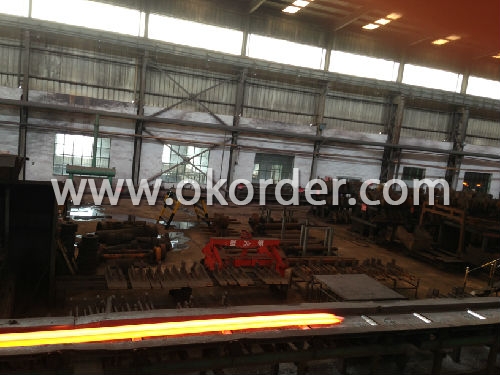
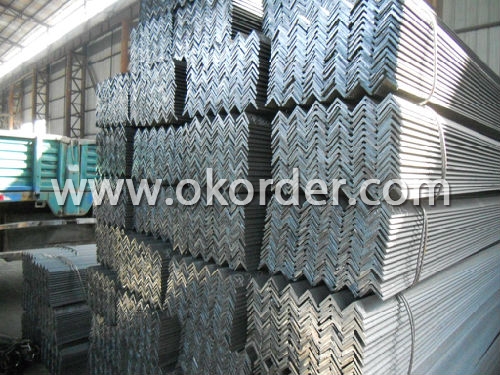
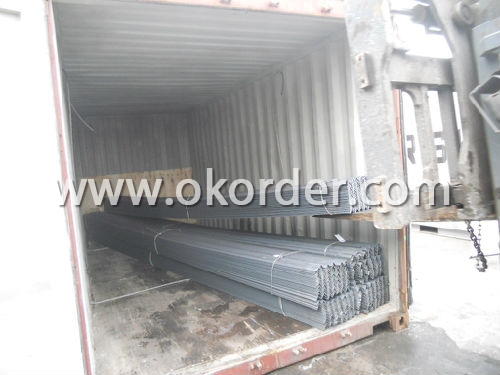
- Q: How many kilograms per square meter is angle steel 63*63*6?
- Angle called angle, the steel strip is perpendicular to each other on both sides into the corner. There are equal angles and unequal angles. The two sides of an equal angle steel are equal in width. The specifications are expressed in millimeters of edge width * edge width * edge thickness. Such as "/ 30 x 30 x 3", that is 30 mm width equal angle, edge thickness of 3 mm. Also available models that model is the number of centimeters wide, such as angle 3#. The model does not mean the size of the different edges and sizes of the same model. Therefore, the width, the edge and the thickness of the angle iron should be filled out in the contract and other documents, so as not to be indicated by the model alone. Standard Specification for hot-rolled equal angle iron is 2#-20#.
- Q: How do steel angles contribute to the overall lateral stability of a structure?
- Steel angles contribute to the overall lateral stability of a structure in several ways. Firstly, they can be used as bracing members to resist lateral forces such as wind or seismic loads. By connecting the angles to the main structural elements of the building, they help to distribute these forces and prevent the structure from collapsing or deforming under the applied load. Additionally, steel angles can be utilized as stiffeners to enhance the stiffness and rigidity of key structural components. By adding angles to beams, columns, or other elements, their resistance to bending or buckling is increased, thereby improving the overall lateral stability of the structure. Moreover, steel angles can act as shear connectors between different structural elements. By welding or bolting angles to beams, for example, they create a connection that enables the transfer of shear forces between the components. This is crucial for ensuring that the structure remains stable and can withstand lateral loads without significant deformation or failure. Furthermore, steel angles can be employed as diagonal members in truss systems. By forming diagonal bracing, they help to distribute the applied loads more evenly across the structure, preventing excessive lateral displacements and maintaining the overall stability of the building. Overall, steel angles play a vital role in enhancing the lateral stability of a structure. Their use as bracing members, stiffeners, shear connectors, and diagonal members all contribute to distributing and resisting lateral forces, ensuring that the structure remains stable and capable of withstanding external loads.
- Q: How to determine the neutral axis of the angle bar?
- The neutral axis is a line which is the intersection of the neutral plane and the neutral axis corresponding to the strong axis of the cross section. The neutral axis is equal to the bisector of the sectional area parallel to the curved main axis, and the area on both sides of the neutral axis is equal, and the biaxial symmetry section is the centroid axis.
- Q: Are steel angles available in different alloys?
- Yes, steel angles are available in different alloys. Steel angles are typically made from carbon steel, which is the most common and versatile type of steel. However, there are also other alloys available for specific applications. For example, stainless steel angles are made from an alloy that contains chromium, which provides increased resistance to corrosion. Additionally, there are high-strength low-alloy (HSLA) steel angles that are made with a combination of carbon steel and small amounts of other elements like manganese, phosphorus, or sulfur to enhance their strength and durability. Overall, the availability of different alloys for steel angles allows for a wide range of applications and properties to meet specific needs in various industries.
- Q: How do steel angles perform in extreme weather conditions?
- Steel angles are designed to be highly durable and resistant to extreme weather conditions. They are commonly used in construction and structural applications due to their strength and ability to withstand harsh environments. In extreme weather conditions such as hurricanes, heavy snowfall, or high winds, steel angles provide excellent protection against these elements. One of the key factors that contribute to the performance of steel angles in extreme weather conditions is their high tensile strength. Steel angles can withstand substantial loads and forces without deforming or breaking, making them ideal for withstanding extreme weather events. Additionally, steel angles are known for their excellent resistance to corrosion, which is crucial in areas with high humidity, saltwater, or acidic environments. Steel angles are also highly versatile, allowing them to be easily fabricated and customized to meet specific project requirements. This flexibility ensures that they can be used in a wide range of applications, including buildings, bridges, towers, and other structures that are exposed to extreme weather conditions. Moreover, steel angles can be coated or treated to further enhance their weather resistance. For example, a galvanized coating can provide added protection against rust and corrosion, extending the lifespan of the steel angles even in the harshest weather conditions. In summary, steel angles are designed to perform exceptionally well in extreme weather conditions. Their high tensile strength, corrosion resistance, and versatility make them a reliable choice for structures that need to withstand hurricanes, heavy snowfall, high winds, and other challenging weather events.
- Q: What are the different methods of joining steel angles?
- There are various methods of joining steel angles, including welding, bolting, riveting, and using adhesive bonds. Each method offers its own advantages and considerations depending on the specific application and requirements.
- Q: Can steel angles be used in electrical or telecommunications applications?
- Steel angles have a wide range of uses in electrical and telecommunications applications. They are highly utilized in the construction and engineering industries because of their strength and versatility. When it comes to electrical applications, steel angles are employed to securely mount electrical equipment like transformers and switchgear. This ensures that they are adequately supported and stable. Furthermore, steel angles can serve as structural components in electrical substations and power transmission towers. In telecommunications, steel angles are valuable as mounting brackets for antennas and satellite dishes. These angles provide a robust and reliable support system, guaranteeing proper signal transmission. Moreover, steel angles find application in cable management systems, effectively organizing and securing electrical or telecommunications cables. Overall, steel angles present a durable and cost-effective solution for a variety of electrical and telecommunications needs.
- Q: How do steel angles perform under wind loads?
- Steel angles are commonly used in construction for their strength and stability. When subjected to wind loads, steel angles perform exceptionally well due to their rigidity and ability to distribute the forces evenly. The shape of the angle, with its two legs forming a right angle, helps to resist bending and twisting caused by wind pressure. Overall, steel angles provide reliable support and structural integrity even in high wind conditions.
- Q: How do you calculate the deflection of a steel angle?
- To determine the deflection of a steel angle, one must take into account various factors and utilize the correct formulas. Typically, the deflection of a beam or angle is calculated using the Euler-Bernoulli beam theory, which assumes small deflections and a slender beam. Initially, the moment of inertia (I) of the steel angle needs to be calculated. This can be done by considering the dimensions and properties of the angle section. The moment of inertia reflects the angle's resistance to bending. Subsequently, the applied load or force (F) acting on the steel angle should be determined. This could be a concentrated load, distributed load, or a combination of both. The load induces a bending moment (M) on the angle. Once the moment of inertia and the bending moment are established, the formula for deflection in a simply supported beam can be employed: To calculate the deflection at the midpoint of the steel angle (δ), use the following equation: δ = (5 * M * L^4) / (384 * E * I) In this equation: - δ represents the deflection at the midpoint of the steel angle - M denotes the bending moment applied to the angle - L signifies the length of the angle - E represents the modulus of elasticity of the steel material - I indicates the moment of inertia of the angle section By substituting the appropriate values into the formula, one can compute the deflection. It is crucial to ensure that the units are consistent and compatible during the calculation process. However, it is important to note that this calculation assumes linear behavior and disregards factors like shear deformation and lateral torsional buckling. For more precise results, additional factors should be taken into account or engineering resources, such as design codes or software, should be consulted for a more accurate deflection calculation.
- Q: Can steel angles be used for architectural detailing or ornamentation?
- Yes, steel angles can be used for architectural detailing or ornamentation. They are commonly used to add structural support, create unique design elements, and enhance the aesthetic appeal of buildings. Their versatility, strength, and durability make them suitable for various architectural applications.
Send your message to us
High Quality Steel Angle Beams for Structure and Construction
- Loading Port:
- Tianjin
- Payment Terms:
- TT or LC
- Min Order Qty:
- 25 m.t.
- Supply Capability:
- 200000 m.t./month
OKorder Service Pledge
OKorder Financial Service
Similar products
Hot products
Hot Searches
Related keywords
